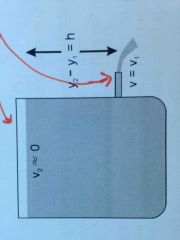![]()
![]()
![]()
Use LEFT and RIGHT arrow keys to navigate between flashcards;
Use UP and DOWN arrow keys to flip the card;
H to show hint;
A reads text to speech;
13 Cards in this Set
- Front
- Back
|
pressure formula, contant density |
P = P0 + ρgh (P0 is pressure at the surface of the fluid, often zero) |
|
|
3 conditions of pressure in static fluid: |
1. pressure over any horizontal surface is equal 2. in the fluid, the force due to the fluid pressure is the same in all directions 3. the force due to the fluid pressure is perpendicular to any surface which the fluid is exerting this force on |
|
|
describe laminar flow |
smooth, flow of particles can be described using flow lines or paths and these paths do not cross each other |
|
|
describe turbulent flow |
erratic, contains eddies (whirlpools) that absorb energy, flow lines can cross |
|
|
use of the Reynolds number |
understanding which regime applies - laminar or turbulent flow |
|
|
describe viscosity |
internal friction, measured by coefficient of viscosity, η (the rate at which the fluid changes its shape) in liquid: weak attractive forces between molecules resist the flow of fluid in gas: collisions between molecules |
|
|
Bernoullis equation |
P1 + 1/2ρv1^2 + ρgh1 = P2 + 1/2ρv2^2 + ρh2 obtained by balancing energies (work done, kinetic energy and gravitational potential energy) then canceling area out on both equation sides. This only works because we are dealing with laminar flow (in data book as footnote) |
|
|
When does Bernoulli's equation apply? |
a fluid that.. has constant density has constant temperature has little to no viscosity has steady or zero flow (laminar!!) (in data book as footnote) |
|
|
Bernoulli's principle |
When flow velocity is high, pressure is low. When flow velocity is low, pressure is high. |
|
|
formula for pressure difference only due to height difference (one of velocities if approx. 0): |

v = sqrt(2gh) |
|
|
downward force on a spherical particle at rest with a fluid flowing overhead |
F-down = weight - bouyancy = 4/3π r^3 (ρs - ρf)g |
|
|
upward force on a spherical particle in fluid flow |
F-up = Bernoulli pressure x cross sectional area = 1/2 ρf v^2 π r^2 |
|
|
describe what happens to a particle that gets lifted by the Bernoulli effect |
- Bernoulli effect causes low pressure above particle, lifts it from riverbed. - Particle will rise if F-up > F-down. - Lift will cease when particle lifted at height approx. 3x its diameter, eventually sink to floor again (unless picked up by turbulent flow!!) - It has moved down stream. |

